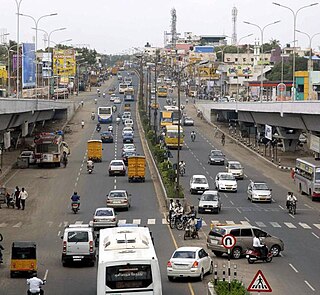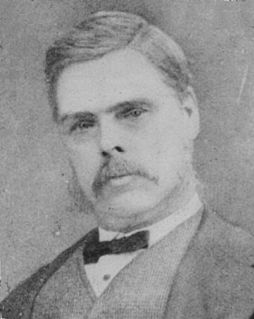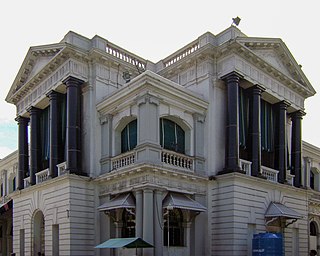
Fort St George is the first English fortress in India, founded in 1644 at the coastal city of Madras, the modern city of Chennai. The construction of the fort provided the impetus for further settlements and trading activity, in what was originally an uninhabited land. Thus, it is a feasible contention to say that the city evolved around the fortress. The fort currently houses the Tamil Nadu legislative assembly and other official buildings.

The Madras Presidency, or the Presidency of Fort St. George, and also known as Madras Province, was an administrative subdivision (presidency) of British India. At its greatest extent, the presidency included most of southern India, including the whole of the Indian states of Tamil Nadu and Andhra Pradesh, and parts of Odisha, Kerala, Karnataka and the union territory of Lakshadweep. The city of Madras was the winter capital of the Presidency and Ootacamund or Ooty, the summer capital. The Island of Ceylon was a part of Madras Presidency from 1793 to 1798 when it was created a Crown colony. Madras Presidency was neighboured by the Kingdom of Mysore on the northwest, Kingdom of Kochi on the southwest, and the Kingdom of Hyderabad on the north. Some parts of the presidency were also flanked by Bombay Presidency.

The Chennai Municipal Corporation, is the civic body that governs the city of Chennai, India. Inaugurated on 29 September 1688, under a Royal Charter issued by King James II on 30 December 1687 as the Corporation of Madras, it is the oldest municipal body of the Commonwealth of Nations outside Great Britain. It is headed by a mayor, who presides over 200 councillors each of whom represents one of the 200 wards of the city. It is the second oldest city civic body in the world after the City of London.

Chennai, formerly known as Madras, is the capital of the state of Tamil Nadu and is India's fourth largest city. It is located on the Coromandel Coast of the Bay of Bengal. With an estimated population of 8.9 million (2014), the 400-year-old city is the 31st largest metropolitan area in the world.

Paradesi Jews were originally Sephardic immigrants to the Indian subcontinent from Sepharad during the 15th and 16th centuries who fled conversion or persecution in the wake of the Alhambra Decree expelling Jews from Spain. They are sometimes referred to as White Jews, although that usage is generally considered pejorative or discriminatory and refers to relatively recent Jewish immigrants, predominantly Sephardim.

Chennai architecture is a confluence of many architectural styles. From ancient Dravidian temples built by the Pallavas, to the Indo-Saracenic style of the colonial era, to 20th-century steel and chrome of skyscrapers. Chennai has a colonial core in the port area, surrounded by progressively newer areas as one travels away from the port, punctuated with old temples, churches and mosques.

Subbiah Muthiah,, was an Indian writer, journalist, cartographer, amateur historian and heritage activist known for his writings on the political and cultural history of Chennai city. He was the founder of the fortnightly newspaper Madras Musings and the principal organizer of the annual Madras Day celebrations. Muthiah was also the founder-President of the Madras Book Club.

Madras Day is a festival organized to commemorate the founding of the city of Madras in Tamil Nadu, India. It is celebrated on 22 August every year, 22 August 1639 being the widely agreed date for the purchase of the village of Madraspatnam or Chennapatnam by East India Company factors Andrew Cogan and Francis Day from Damarla Venkatadri Nayaka, the viceroy of the Vijayanagar Empire.

Anna Salai, formerly known as St. Thomas Mount Road or simply Mount Road, is an arterial road in Chennai, India. It starts at the Cooum Creek, south of Fort St George, leading in a south-westerly direction towards St. Thomas Mount, and ends at the Kathipara Junction in Guindy. Beyond the Kathipara Junction, a branch road arises traversing westwards to Poonamallee to form the Mount-Poonamallee Road while the main branch continuing southwards to Chennai Airport, Tambaram and beyond to form Grand Southern Trunk Road. Anna Salai, which is more than 400 years old, is acknowledged as the most important road in Chennai city. The head offices of many commercial enterprises and public buildings are located along Anna Salai. It is the second longest road in Chennai, after Poonamallee High Road.
Beri Thimappa / Thimmanna was the dubash (interpreter) and chief negotiator for Francis Day and Andrew Cogan, the agents of the British East India Company, and was instrumental in the purchase of Madras from the Nayak brothers. Beri Thimmappa migrated in the early 17th century to Chennai from palakollu, near Machilipatnam in Andhra Pradesh. He established a Black Town outside the walls of the newly built Fort of Madras which later became Fort St George.

George Town is a neighbourhood in Chennai city, Tamil Nadu, India. It is near the Fort Saint George, Chennai. It is also known as Muthialpet and Parry's corner. It is an historical area of Chennai city from where its expansion began in the 1640s. It extends from the Bay of Bengal in the east to Park town on the west. The Fort St. George is on the south, to Royapuram in the North. The Fort St. George houses the Tamil Nadu Legislative Assembly and the Secretariat. The High court of Tamil Nadu at Chennai, Dr. Ambedkar Law College, Stanley Medical College and Hospital are located here.

Mallikesvarar Temple or Mallikarjunar Temple is a Hindu temple situated in the neighbourhood of George Town in the city of Chennai, India. It is one of the first Hindu temples to be constructed in the British settlement of Madrasapatnam. There is the nearby Chenna kesava perumal Temple. They are twin temples. This is also called Chenna Malleeswarar temple. Chenna pattanam may be named after this deities. The word 'chenni' in Tamil means face, and the temple was regarded as the face of the city.

Taj Connemara, Chennai is a five-star hotel in Chennai, India. It is a heritage hotel in Chennai. Classified under the Taj Group's business hotels section, the hotel is considered the oldest hotel in the city.
Chennai, along with Mumbai, Delhi and Kolkata, is one of the few Indian cities that are home to a diverse population of ethno-religious communities. According to the 2011 census Chennai then had a total population of 4,681,087 at a density of 26,902 per square kilometre; the sex ratio was 986 and literacy rate was 90.33%. The most widely spoken languages are Tamil and English. Hinduism is followed by a majority of the populace followed by Islam and Christianity. Sikhism, Jainism, Buddhism and Zoroastrianism are other religions practiced.
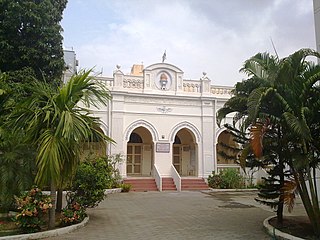
Jal Phiroj Clubwala Dar E Meher, popularly known as the Royapuram fire temple, is a Parsi fire temple at Royapuram, Chennai, India. It was built in 1910 and donated to the Madras Parsi Zarthosti Anjuman by philanthropist Phiroj M. Clubwala. The temple is one of the 177 odd fire temples in the world, of which some 150 are in India. It is the only Parsi fire temple in Tamil Nadu and surrounding region, including Puducherry and Kerala. The flame in the temple is burning continuously ever since the temple was built and is stoked five times a day by the priest.
Chennai is religiously cosmopolitan, with its denizens following various religions, chief among them being Hinduism, Islam, Christianity, Sikhism, Jainism, Buddhism, and Zoroastrianism. Chennai, along with Mumbai, Delhi and Kolkata, is one of the few Indian cities that are home to a diverse population of ethno-religious communities. With the majority of the people in India following Hinduism, Chennai, like other Indian cities, is home to more Hindus than any other religion. Chennai has centres of worship for a multitude of faiths. According to 2001 census, majority of the population are Hindus, Muslims, Christians, Jains, Sikhs, and Buddhists.
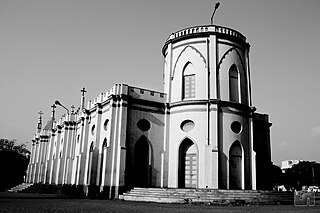
St. Peter's Church is one of the oldest churches in Royapuram area of Chennai, the capital of the South Indian state of Tamil Nadu. The original structure was built in Gothic architecture in 1829 by Gurukula Vamsha Varnakula Mudaliars, a gang of boatmen who were serving the East India Company.


